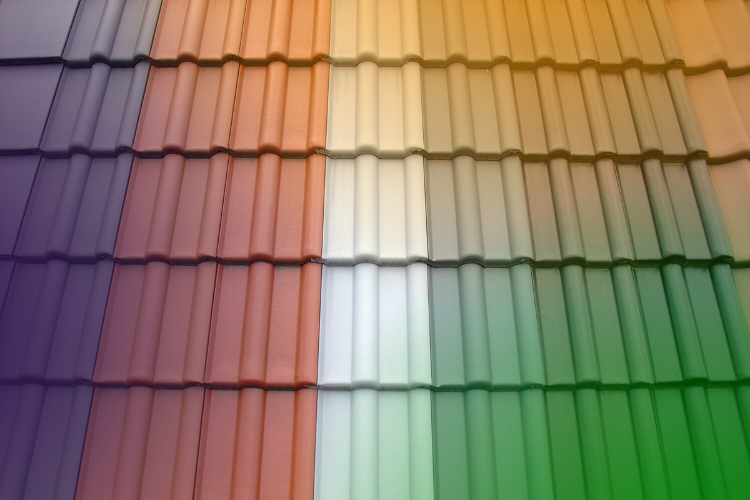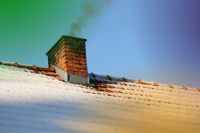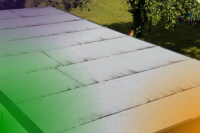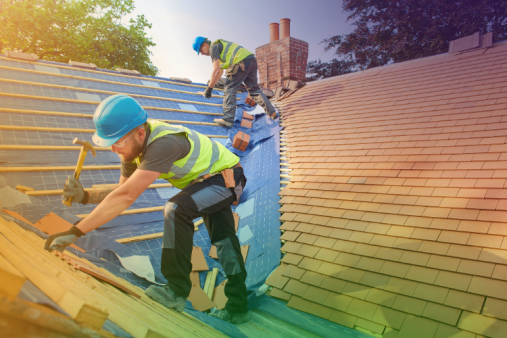A guide to different roof tiles
If you’ve travelled around the UK, you’ll be aware that there’s lots of regional differences in what we use to make our roofs. This is mainly down to what materials were traditionally available locally. If you’re thinking about replacing your roof, you may have the freedom to go for a different type fo roofing to the convention in your area. All types of tiles have their advantages and disadvantages though.
Different types of roof tiles
There are several types of roof tiles commonly used in the UK, each with its own unique characteristics and benefits. Some of the most common types of roof tiles include:
-
Concrete tiles: Concrete tiles are a popular choice for their durability and cost-effectiveness. They come in a variety of colours and styles to suit different architectural styles.
-
Clay tiles: Clay tiles are known for their natural beauty and long-lasting performance. They are available in a range of colours and styles, and can be a good choice for traditional or historical buildings.
-
Slate tiles: Slate tiles are a premium roofing material known for their durability and resistance to weathering. They have a natural, rustic look that can add character to a building.
-
Metal tiles: Metal tiles are becoming increasingly popular due to their durability, energy efficiency, and aesthetic appeal. They can be made from a variety of metals, including steel, copper, and aluminium, and are available in a range of colours and styles.
-
Synthetic tiles: Synthetic tiles are made from plastic or composite materials and are designed to mimic the look of natural materials like clay or slate. They are lightweight, durable, and can be a good choice for eco-friendly roofing solutions.
-
Bitumen tiles: Bitumen tiles, also known as asphalt shingles, are a cost-effective roofing material that is easy to install. They come in a range of colours and styles and can be a good choice for residential or commercial buildings.
It is important to consider factors such as durability, cost, and aesthetics when selecting the right type of roof tiles for your building. Additionally, the type of tile may depend on the pitch of your roof and the local climate in your area.
Detail on different types of tiles for your roof
Clay roof tile
Clay tiles are the main type of tile found in the southern half of England, and are usually red or grey in colour. This is a natural material with a great deal of variation and can add character to the roof of a newer property. It’s a popular Mediterranean look, but the downside to clay tiles is that they can be brittle. If water gets in and freezes, a cracked tile can easily cause leaks. Clay tiles are cheap and come in a range of different sizes. Reclaimed clay tiles can also keep the Council planning department happy if you are trying to match a new roof in with neighbouring properties.
Concrete roof tiles
Modern manufacturing techniques mean that tiles can be made out of concrete to mimic the appearance of slate or clay. The downside to concrete is that you don’t get the natural variation that you would with natural clay. Concrete tiles are very durable and hardwearing, and no as prone to cracks as other types of tiles. They’re also cheap to buy and can be easily picked up from any major builder’s merchants. Concrete is heavy though, and you might have to pay for roof reinforcement to support the weight of the tiles.
Slates
Slate is the predominant roofing material in the north of England and Scotland. Slate is another natural roofing product which has natural colour variation. Slate tiles can be heavy though, so unless you are just replacing slates on an existing roof, you might have to reinforce the beams to bear the weight. Slate can also be brittle, and tricky to nail onto the roof. It’s essential that you work with a contractor who has experience working with slate and sealing your roof to ensure it is watertight.
Synthetic roof tiles
Synthetic roof tiles are roofing materials made from synthetic materials such as plastic or composite materials, designed to mimic the look of natural materials like clay, slate, or wood.
Synthetic roof tiles are becoming increasingly popular in the UK due to their durability, lightweight, and eco-friendly characteristics. They are available in a range of colours and styles, and can be a good choice for those who want the look of natural roofing materials but with added benefits such as increased resistance to weathering and lower maintenance requirements.
Some of the benefits of synthetic roof tiles include:
-
Durability: Synthetic tiles are designed to withstand harsh weather conditions and can last for many years without the need for replacement.
-
Lightweight: Synthetic tiles are typically lighter than natural materials, making them easier to install and reducing the load on the roof structure.
-
Eco-friendly: Synthetic tiles can be made from recycled materials and can be recycled at the end of their life, making them a more sustainable choice.
-
Low maintenance: Synthetic tiles require less maintenance than natural materials, as they are less susceptible to damage from weathering or insects.
In summary, synthetic roof tiles are a popular choice in the UK due to their durability, lightweight, and eco-friendly properties. They can be a good choice for those who want the look of natural roofing materials with added benefits.
Bitumen roof tiles
Bitumen roof tiles, also known as asphalt shingles, are a type of roofing material made from asphalt that is reinforced with fiberglass or organic materials. They are a popular roofing material in the UK and around the world, particularly for residential buildings.
Bitumen roof tiles are popular due to their cost-effectiveness, durability, and ease of installation. They are available in a range of colours and styles, and can be a good choice for those who want a low-maintenance roofing solution.
Some of the benefits of bitumen roof tiles include:
-
Cost-effectiveness: Bitumen roof tiles are a cost-effective roofing solution that can help save money on installation and maintenance costs.
-
Durability: Bitumen roof tiles are designed to withstand harsh weather conditions and can last for many years without the need for replacement.
-
Easy installation: Bitumen roof tiles are easy to install and can be a good choice for those who want a quick and hassle-free installation process.
-
Low maintenance: Bitumen roof tiles require minimal maintenance and can be a good choice for those who want a low-maintenance roofing solution.
In summary, bitumen roof tiles are a popular roofing material in the UK due to their cost-effectiveness, durability, ease of installation, and low maintenance requirements. They can be a good choice for residential buildings and other structures where cost and ease of installation are important factors.
Alternative Roofing Options
There’s a growing trend for homeowners to express their individuality through their roof choices. There are lots of weird and wacky ideas out there. Metal roofing is common in other countries, but hasn’t really caught on here due to the risk of rusting. A living roof appeals to those with an environmental outlook, as plants can be grown on the roof over a waterproof membrane. Rubber is a good choice for flat roofs, and can be produced in a wide range of colours too. Thatching is one of the oldest methods of roofing in the UK and is coming back into fashion as some owners want to get back to traditional ways of doing things. A professionally thatched roof can last for up to 30 years, and is guaranteed to give your home that chocolate-box appeal.
Living roof
A living roof, also known as a green roof or vegetated roof, is a roof covered with vegetation such as grass, flowers, or other plants. It is typically installed over a waterproof membrane and can provide a range of environmental benefits, including insulation, stormwater management, and habitat creation.
Living roofs are growing in popularity in the UK, particularly in urban areas where green space is limited. They can be installed on a range of buildings, from residential homes to commercial buildings, and can be designed to suit a range of climates and vegetation types.
Some of the benefits of living roofs include:
-
Insulation: Living roofs can provide additional insulation to buildings, reducing energy costs and improving energy efficiency.
-
Stormwater management: Living roofs can absorb and retain rainwater, reducing the amount of stormwater runoff and helping to prevent flooding.
-
Habitat creation: Living roofs can provide habitat for wildlife, particularly in urban areas where green space is limited.
-
Air quality: Living roofs can help to improve air quality by filtering pollutants from the air.
In summary, living roofs are an increasingly popular roofing option in the UK due to their environmental benefits, particularly in urban areas. They can provide insulation, stormwater management, habitat creation, and improved air quality, and can be designed to suit a range of building types and climates.








